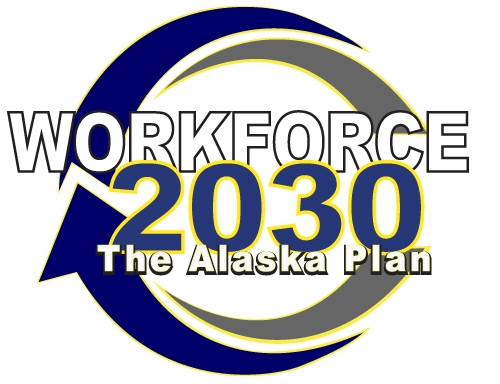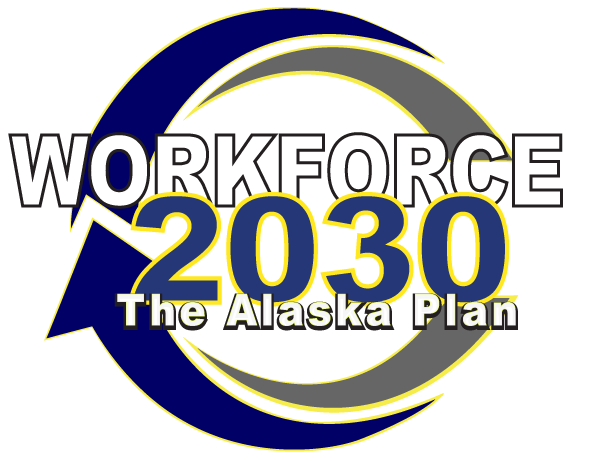Workforce 2030: A New Plan for a New Challenge

Each year more working age people leave Alaska than move here for work. More than half of high school graduates leave and most don’t return. At the same time, Alaska’s economy is growing.
- $20 billion in new infrastructure and resource development projects over five years
- 10,000 new workers needed now as our workforce ‘ages out’ (see more)
- 20,000 additional new workers needed by 2030
Now Industry and the State of Alaska join together to create a unique workforce plan to help build Alaska one community at a time. Workforce 2030 – The Alaska Plan is a platform to address labor shortages, retain our talent, and deliver reskilling, upskilling, and next-skilling. (see press release)
The Workforce 2030 Industry Advisory Council (IAC) sets the strategic direction, selects priorities, and steers the plan to achieve results. Already, the Council sees communication and collaboration among employers, educators, and government agencies as a top priority. (see more)
- In the next month, the Workforce 2030 Team will request the advice of employers, educators, associations, Native Alaskan entities, unions, and others statewide. (see employer survey)
- Most uniquely, the Team will pursue input from students, young adults, and new job seekers. Their views on career pathways for the job market and Career and Technical Education in Alaska are central, as most other states face similar labor shortages. (see student survey)
Getting this done right is vital for every business, every employer, and every community. If we meet our workforce challenges, we will have a prosperous future. We invite you to join this effort.
The Alaska Safety Alliance (ASA) and the State of Alaska (SOA) have joined to create a unique cross-industry workforce development plan that will provide action steps to address critical labor shortages that impact every industry, government agency, and community.
This plan is being produced with support from the Denali Commission, the Alaska Department of Labor and Workforce Development, Alaska Workforce Investment Board, and the Alaska Department of Education and Early Development.
COMMENTS
We encourage you to share your comments about this content. If you are not a registered user, your comment will not post until approved. You may register as a user if you want your comment posted sooner. When posting, if you do not want your name to appear, please type 'Anon' or your favorite handle in the name field.
- Add new comment
- 1863 views
Page Comments
New Residency Requirement for UA
I work for SERRC in Juneau. We utilize AKDOLWD funding to support participants for training and utilize UAS Career Education for workforce courses in construction, welding, mechanics, mining and healthcare. We were recently notified that participants need to have one year of Alaska residency to take more than one credit of training. That means as we encourage people to move to Alaska to enhance our workforce we will make them wait one year before we can enroll them in training at a resident rate of tuition. This delays a trained workforce. Our grants are not funded high enough to pay non-resident tuition rates. In the past, it was four credits. To build our workforce all career education courses should be at resident tuition rates. What kind of advocacy to the UA Board of Regents is available to address this?
Providing Clarification on UA Residency Requirement
Residency requirements went from two years to one year to align with PFD requirements and provide residency rates sooner. After one year, students receive residence rates for all classes. During the first year, students receive one credit at the resident rate.
I am a healthcare…
I am a healthcare professional with young children. The costs of childcare (if you can find it) is astronomical for most families. Additionally, there’s been a loud and clear message that our elected officials don’t value education. My children’s future is my priority. If we didn’t already live here, I would never consider relocating to this state. Alaska is not very welcoming for families.
Re: I am a healthcare professional with young children
Tricia, thank you for your comments. We have heard from many that childcare is a major challenge for them, and that education is a top priority. We encourage you to create a free account on this website (there is a Create Account link at the bottom of the page) and then join an interest group and participate in the forums to engage in conversations with others and to provide more input. We appreciate your interest in the Workforce 2030 plan.
Transitioning Military and Veterans
We have an amazing resource pool for our future talent needs in our military personnel who are stationed he and want to stay or return when they transition out; or who are here, and looking for work. I've heard that they have a challenging time matching their military training, skills, and experience to our jobs, and in the face of 1000 open jobs, we have veterans who cannot find a job. I'm not an expert on this issue, but I've worked on it enough to know that in entrepreneurship and supporting new business creation, they face a steep challenge of finding resources and accessing promised but always just out-of-reach assistance. I'd like to see the 2030 plan have a specific section focused on military-related workforce needs and opportunities related to supporting the military installation and activities in the state, and the personnel here and who might want to return... I'm betting if we just figure out how to keep the people we have (residents, HS/U graduates, and military personnel), that most of our workforce issues would be solved. I refer to it as the "Alaska Escalator" that sends folks to the L48 and then invests in attracting new folks to come up... we need to stop the escalator. Ky
Alaska has Robust Support for Military Workforce Opportunity
The Alaska Department of Labor and Workforce Development (DOLWD) is highly dedicated to providing transitioning service members, veterans, and military spouses with the tools and opportunities needed to be successful in obtaining meaningful and gainful employment. Priority of Service is provided to all eligible veterans and covered persons, meaning that these individuals receive head-of-the-line privileges for all programs funded either in whole or in part by the USDOL. I have posted a more compete discussion on this issue in the Government Forum.
Deaf resident
Often after high school graduations, not many deaf people have good, sustainable employment or living experience. I am concerning about deaf program of Alaska, school has lack of support for deaf students especially their career paths.

Add new comment